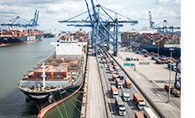Can Trump’s merchant fleet survive the realities of global shipping?
 The Trump administration’s push to revive a US-flagged merchant fleet under the SHIPS for America Act is bold, nostalgic, and politically charged. The Trump administration’s push to revive a US-flagged merchant fleet under the SHIPS for America Act is bold, nostalgic, and politically charged.
It evokes the era of Liberty ships and wartime logistics, when American-built vessels carried the weight of Allied victory across the oceans. But in today’s hyper-efficient, consolidated, and globalised shipping industry, the practicality of such a vision is questionable.
The administration’s counter-revolution against left-leaning governments in the Western Anglosphere and Western Europe - frames this initiative as part of a larger effort to restore national sovereignty, economic independence and military readiness.
Tariffs are central to this strategy, intended to rebalance trade relations and lure overseas manufacturers to American soil. Alongside this, sweeping reductions in public service headcount are meant to energise voters and sustain the movement beyond the mid-terms. But whether these efforts can culminate in a viable US-flagged merchant fleet is another matter.
Since World War II, merchant shipping has been dominated not by national fleets but by the “wretched of the earth” - globalised labour force working aboard vessels flying flags of convenience. After the war, surplus Liberty and Victory ships were sold off, often to Greek shipowners who built empires on rusting steel.
The US, once a maritime titan, shrank to a shadow of its former self. The need for a vast fleet evaporated with peace, and the rise of jet travel in the late 1950s further eroded the dominance of ocean liners.
The container revolution, sparked by Malcom McLean’s 1956 experiment of loading 58 containers onto a converted tanker in New Jersey and sailing them to Houston, changed everything. It was cheaper and faster than trucking, especially before the Interstate Highway System was built. McLean’s Sea-Land Service helped give birth to the Asian tiger economies by enabling exports at scale, shifting the centre of gravity from the transatlantic to the transpacific.
Bulk and liquid trades also flourished, driven by Soviet crop failures and industrial demand for coal and iron ore. But geopolitical shocks also reshaped the industry. The Six-Day War in 1967 closed the Suez Canal for nearly a decade, forcing oil tankers to reroute around the Cape of Good Hope. The 1973 oil shock, triggered by OPEC’s embargo, quadrupled crude prices and accelerated the rise of supertankers - some reaching 340,000 deadweight tons - to maintain profitability over longhauls.
Meanwhile, Japan emerged as a shipbuilding powerhouse, producing most of the world’s supertankers and later pivoting to containerships. But the Japanese miscalculated. While eastbound cargo to the US was lucrative, westbound exports - grain, coal, potash - were ill-suited to containers. Sea-Land’s success was underwritten by Pentagon contracts during the Vietnam War, which paid for both headhaul and backhaul voyages. The backhaul, once thought empty, proved rich with US-bound cargo, creating a virtuous cycle of trade.
Alarmed by Sea-Land’s dominance, Japanese carriers like “K” Line, MOL, and NYK eventually merged their container operations into Ocean Network Express (ONE), based in Singapore. But by then, the industry was already consolidating. From 20 major carriers in 2000, the field has shrunk to a half dozen through aggressive mergers and acquisitions. Maersk acquired P&O Nedlloyd in 2005 and Hamburg Sud in 2017. Hapag-Lloyd absorbed CSAV and UASC. CMA CGM took over NOL (APL), and COSCO merged with China Shipping and later acquired OOCL.
Today’s mega-carriers are not just shipping lines - they are vertically integrated logistics empires. Maersk, MSC, CMA CGM, and COSCO own terminals, freight forwarders, and even air cargo fleets. Maersk’s APM Terminals manages over 70 facilities. MSC became the largest terminal operator after acquiring Bollore Africa Logistics. CMA CGM owns CEVA Logistics and operates freighters under CMA CGM Air Cargo. These companies offer end-to-end solutions, from factory to doorstep, across multiple transport modes.
In this context, the Trump administration’s plan to build a US-flagged merchant fleet faces gale force headwinds. The primary advantage of ocean shipping is cost efficiency, driven by automation and scale. Liberty ships of 11,000 tons required a 40-man crew; today’s 223,000-ton containerships need fewer than 20. Building and operating ships under the US flag is significantly more expensive due to labour costs, regulatory burdens, and shipbuilding constraints. These realities clash with the administration’s goal of job creation.
Strategic independence is another motivator. With China’s military buildup and assertiveness in the South China Sea, reliance on foreign-flagged shipping poses risks. The administration’s support for Ukraine may be partly aimed at clearing out old military stockpiles and rearming for future conflicts. There’s also a cultural dimension: a desire to purge the military of “meta sexuals” and DEI policies, and return to traditional values of uniformity and discipline. As the Romans said, “Prepare for war and enjoy peace.”
But building a merchant fleet is not just about ideology- it’s about economics, infrastructure, and global integration. The US lacks the shipbuilding capacity to compete with South Korea and China. Ports are not optimised for US-flagged operations, and the Jones Act, while protective, has stifled innovation and raised costs. Without a clear commercial incentive, carriers will not switch flags. And without sustained political will, the initiative may falter after the next election cycle.
Tariffs may encourage some reshoring of manufacturing. The hope is that reciprocal trade relations will emerge, and overseas firms will invest in US factories. But global supply chains are complex, and businesses are wary of political volatility. |